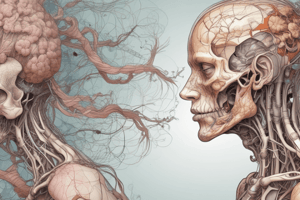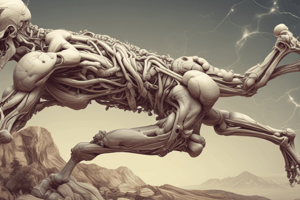Podcast
Questions and Answers
What is the study of body structures called?
What is the study of body structures called?
- Biology
- Anatomy (correct)
- Pathology
- Physiology
What does physiology study?
What does physiology study?
- Chemical processes
- Body structures
- How body structures function (correct)
- Diseases
What is the anatomical term for the front or belly side?
What is the anatomical term for the front or belly side?
Anterior or Ventral
What is the anatomical term for the back side?
What is the anatomical term for the back side?
What does the term 'superior' refer to in anatomy?
What does the term 'superior' refer to in anatomy?
What does 'inferior' mean in anatomical terms?
What does 'inferior' mean in anatomical terms?
What does medial refer to?
What does medial refer to?
What does lateral refer to?
What does lateral refer to?
What does bilateral mean?
What does bilateral mean?
What does proximal refer to?
What does proximal refer to?
What does distal mean?
What does distal mean?
What does superficial refer to in anatomical terms?
What does superficial refer to in anatomical terms?
What does deep mean regarding anatomical direction?
What does deep mean regarding anatomical direction?
What is the anatomical term for the body's right side?
What is the anatomical term for the body's right side?
What does the term left refer to in anatomy?
What does the term left refer to in anatomy?
What does axial refer to in anatomy?
What does axial refer to in anatomy?
What does abdominal refer to?
What does abdominal refer to?
What does cephalic or cranial refer to?
What does cephalic or cranial refer to?
What does cervical refer to?
What does cervical refer to?
What does inguinal refer to?
What does inguinal refer to?
What does thoracic refer to?
What does thoracic refer to?
What does umbilical refer to?
What does umbilical refer to?
What does appendicular refer to in anatomy?
What does appendicular refer to in anatomy?
What does plantars refer to?
What does plantars refer to?
The ______ separates the right from the left.
The ______ separates the right from the left.
What does transverse refer to?
What does transverse refer to?
What does frontal or coronal refer to?
What does frontal or coronal refer to?
What does supine mean in anatomical terms?
What does supine mean in anatomical terms?
What does prone refer to?
What does prone refer to?
What does homeostasis refer to?
What does homeostasis refer to?
What is negative feedback in homeostasis?
What is negative feedback in homeostasis?
What is positive feedback in homeostasis?
What is positive feedback in homeostasis?
Study Notes
Anatomy and Physiology Essentials
- Anatomy: Focuses on the structures of the body.
- Physiology: Explores the functions and processes of body structures.
Anatomical Directions
- Anterior/Ventral: Refers to the front or belly side of the body.
- Posterior/Dorsal: Pertains to the back side.
- Superior: Direction towards the head.
- Inferior: Direction away from the head.
- Medial: Positioned towards the midline of the body.
- Lateral: Positioned away from the midline.
- Bilateral: Relates to both sides of the body.
- Proximal: Closer to the body's connection point.
- Distal: Farther from the body's connection point.
- Superficial: Closer to the surface of the body.
- Deep: Farther from the surface.
Anatomical Regions
- Axial: Comprises the head, neck, and trunk.
- Abdominal: Relates to the belly area.
- Axillary: Pertains to the armpit region.
- Cephalic/Cranial: Refers to the head.
- Cervical: Involves the neck area.
- Facial: Relates to the face.
- Inguinal: Pertains to the groin.
- Pelvic: Lower trunk area.
- Thoracic: Concerns the chest region.
- Umbilical: Involves the navel area.
- Appendicular: Covers the arms and legs.
Anatomical Planes
- Sagittal: Divides the body into right and left; midsagittal is down the midline.
- Transverse/Horizontal: Divides the body into upper and lower parts.
- Frontal/Coronal: Separates anterior from posterior.
- Supine: Body position facing upwards.
- Prone: Body position facing downwards.
Anatomical Cavities
- Dorsal Cavity: Contains cranial and vertebral cavities (brain and spinal cord).
- Thoracic Cavity: Includes pleural cavities (lungs) and pericardial cavity (heart).
- Abdominopelvic Cavity: Contains abdominal (digestive organs) and pelvic (urinary and reproductive organs) cavities.
Body Membranes
- Pleura: Serous membrane surrounding the lungs.
- Visceral Pleura: Membrane in direct contact with lungs.
- Parietal Pleura: Membrane not in contact with lungs.
- Peritoneum: Serous membrane in the abdominopelvic cavity.
Homeostasis
- Definition: The body's ability to maintain stable internal conditions.
- Negative Feedback: Mechanism that reverses changes to restore balance.
- Positive Feedback: Mechanism that enhances changes, pushing away from homeostasis.
Levels of Organization
- Hierarchical structure: Chemical, Organelle, Cell, Tissue, Organ, Organ System, Organism.
Major Elements in the Human Body
- Elements include Oxygen, Carbon, Hydrogen, Nitrogen, Calcium, Phosphorus, Sulfur, and Potassium.
Water's Functions
- Separates ions, acts as a lubricant, aids chemical reactions, assists in transport, and regulates temperature.
Solutions and Concentration
- Body fluids consist of solutes and solvents; concentration indicates solute amount relative to solvent.
Tonicity Types
- Hypertonic: Higher solute concentration.
- Isotonic: Equal solute concentration.
- Hypotonic: Lower solute concentration.
Organic Molecules
- Must contain carbon and hydrogen. Types include Carbohydrates, Lipids, Proteins, and Nucleic Acids.
Carbohydrates
- Composed of carbon, hydrogen, and oxygen in a 1:2:1 ratio.
- Monosaccharides: Simple sugars like glucose, the cell's major fuel.
- Disaccharides: Two monosaccharides linked.
- Polysaccharides: Many monosaccharides connected.
Lipids, Proteins, and Nucleic Acids
- Lipids: Composed of C, H, O but not in a fixed ratio; building blocks include fatty acids and glycerol.
- Proteins: Contain nitrogen, composed of 20 amino acids.
- Nucleic Acids: Made of C, H, O, N, phosphorus; includes DNA and RNA.
Metabolism
- Sum of all biological chemical reactions; influenced by reactant concentration, temperature, and catalysts.
Cellular Respiration and Energy
- Chemical reaction: Glucose + Oxygen yields Carbon Dioxide + Water, producing energy to form ATP.
Cell Structures and Functions
- Cytoplasm: Fluid within cells, housing organelles and nutrients.
- Cell Membrane: Provides structure and regulates entry/exit of substances via transport.
Membrane Transport
- Passive Transport: No energy needed for material movement across membranes.
- Active Transport: Requires energy for movement.
Tissue Types
- Epithelial Tissue: Covers and lines surfaces; classified by shape and layers.
- Connective Tissue: Consists of cells and fibers in a matrix; types vary based on density and structure.
- Muscle Tissue: Comprises skeletal, smooth, and cardiac muscle with high protein concentration.
- Nervous Tissue: Made of neurons and neuroglia, varies in size and shape.
Epithelial Tissue Characteristics
- Covers all surfaces, named by cell shape and layer count, can be squamous (flat), cuboidal (square), or columnar (tall).
Cell Layer Classifications
- Simple: One cell layer.
- Stratified: Multiple cell layers.
- Pseudostratified: Appears multilayered but is one layer.
Studying That Suits You
Use AI to generate personalized quizzes and flashcards to suit your learning preferences.
Description
Test your knowledge of key terms in Anatomy and Physiology with these flashcards covering chapters 1 to 4. Each card presents essential vocabulary and their definitions to help reinforce your understanding of body structures and functions.





